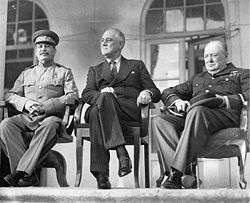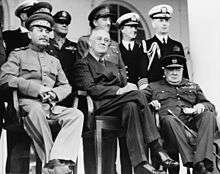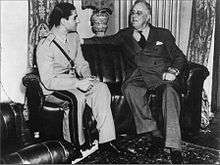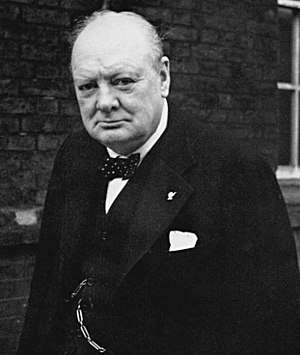Tehran Conference
 The "Big Three" at the Tehran Conference Left to right: Joseph Stalin, Franklin D. Roosevelt and Winston Churchill. | |
| Date | 28 November 1943 to 1 December 1943 |
|---|---|
| Location | Soviet embassy, Tehran, Iran |
| Also known as | Tehran Summit |
| Participants |
Winston Churchill (Prime Minister: United Kingdom), Franklin D. Roosevelt (President: United States) Joseph Stalin (Premier: Soviet Union) |
| Outcome | Consensus to open a second front against Nazi Germany by 1 May 1944 |
The Tehran Conference (codenamed Eureka[1]) was a strategy meeting of Joseph Stalin, Franklin D. Roosevelt, and Winston Churchill from 28 November to 1 December 1943, after the Anglo-Soviet Invasion of Iran. It was held in the Soviet Union's embassy in Tehran, Iran. It was the first of the World War II conferences of the "Big Three" Allied leaders (the Soviet Union, the United States, and the United Kingdom). It closely followed the Cairo Conference which had taken place on 22–26 November 1943, and preceded the 1945 Yalta and Potsdam conferences. Although the three leaders arrived with differing objectives, the main outcome of the Tehran Conference was the Western Allies' commitment to open a second front against Nazi Germany. The conference also addressed the 'Big Three' Allies' relations with Turkey and Iran, operations in Yugoslavia and against Japan, and the envisaged post-war settlement. A separate protocol signed at the conference pledged the Big Three to recognize Iran's independence.
Prelude
As soon as the German-Soviet war broke out in June 1941, Churchill offered assistance to the Soviets, and an agreement to this effect was signed on 12 July 1941.[2] Delegations had traveled between London and Moscow to arrange the implementation of this support and when the United States joined the war in December 1941, the delegations met in Washington as well. A Combined Chiefs of Staff committee was created to coordinate British and American operations as well as their support to the Soviet Union. The consequences of a global war, the absence of a unified Allied strategy and the complexity of allocating resources between Europe and Asia had not yet been sorted out, and soon gave rise to mutual suspicions between the Western Allies and the Soviet Union.[2] There was the question of opening a second front to alleviate the German pressure on the Soviet Red Army on the Eastern Front, the question of mutual assistance (where both Britain and the Soviet Union were looking towards the United States for credit and material support and there was tension between the United States and Britain since Washington had no desire to prop up the British Empire in the event of an Allied victory).[2] Also, neither the United States nor Britain were prepared to give Stalin a free hand in Eastern Europe and, lastly, there was no common policy on how to deal with Germany after Hitler. Communications regarding these matters between Churchill, Roosevelt, and Stalin took place by telegrams and via emissaries—but it was evident that direct negotiations were urgently needed.[2]
Stalin was reluctant to leave Moscow and was unwilling to risk journeys by air,[3] while Roosevelt was physically disabled and found travel difficult. Churchill was an avid traveller and, as part of an ongoing series of wartime conferences, had already met with Roosevelt five times in North America and twice in Africa and had also held two prior meetings with Stalin in Moscow.[2] In order to arrange this urgently needed meeting, Roosevelt tried to persuade Stalin to travel to Cairo. Stalin turned down this offer and also offers to meet in Baghdad or Basra, finally agreeing to meet in Tehran in November 1943.[2]
Proceedings

The conference was to convene at 16:00 on 28 November 1943. Stalin arrived well before, followed by Roosevelt, brought in his wheelchair from his accommodation adjacent to the venue. Roosevelt, who had traveled 7,000 miles (11,000 km) to attend and whose health was already deteriorating, was met by Stalin. This was the first time that they had met. Churchill, walking with his general staff from their accommodations nearby, arrived half an hour later.[4] According to Charles Bohlen, translator for FDR, FDR was accompanied by Averell Harriman and Harry Hopkins. Stalin was accompanied by Molotov and Voroshilov. Churchill brought Anthony Eden and Lord Ismay, and his translator was Major Arthur Birse.

As Stalin had been advocating for a second front since 1941, he was very pleased and felt that he had accomplished his principal goal for the meeting. Moving on, Stalin agreed to enter the war against Japan once Germany was defeated.
Stalin pressed for a revision of Poland’s eastern border with the Soviet Union to match the line set by British Foreign Secretary Lord Curzon in 1920. In order to compensate Poland for the resulting loss of territory, the three leaders agreed to move the German-Polish border to the Oder and Neisse rivers. This decision was not formally ratified, however, until the Potsdam Conference of 1945.[5]
The leaders then turned to the conditions under which the Western Allies would open a new front by invading northern France (Operation Overlord), as Stalin had pressed them to do since 1941. Up to this point Churchill had advocated the expansion of joint operations of British, American, and Commonwealth forces in the Mediterranean, as Overlord in 1943 was physically impossible due to a lack of shipping, which left the Mediterranean and Italy as viable goals for 1943. It was agreed Overlord would occur by May 1944; Stalin agreed to support it by launching a concurrent major offensive on Germany's eastern front to divert German forces from northern France.[6]
Iran and Turkey were discussed in detail. Roosevelt, Churchill, and Stalin all agreed to support Iran's government, as addressed in the following declaration:
The Three Governments realize that the war has caused special economic difficulties for Iran, and they all agreed that they will continue to make available to the Government of Iran such economic assistance as may be possible, having regard to the heavy demands made upon them by their world-wide military operations, and to the world-wide shortage of transport, raw materials, and supplies for civilian consumption.[7]
In addition, the Soviet Union was required to pledge support to Turkey if that country entered the war. Roosevelt, Churchill and Stalin agreed that it would also be most desirable if Turkey entered on the Allies' side before the year was out.
Despite accepting the above arrangements, Stalin dominated the conference. He used the prestige of the Soviet victory at the Battle of Kursk to get his way. Roosevelt attempted to cope with Stalin's onslaught of demands, but was able to do little except appease Stalin. Churchill argued for the invasion of Italy in 1943, then Overlord in 1944, on the basis that Overlord was physically impossible in 1943 due to lack of shipping and it would be unthinkable to do anything major until it could be launched.[8]
Churchill proposed to Stalin a moving westwards of Poland, which Stalin accepted, which gave the Poles industrialized German land to the west and gave up marshlands to the east, while providing a territorial buffer to the Soviet Union against invasion.
Dinner meeting
Before the Tripartite Dinner Meeting of 29 November 1943 at the Conference, Churchill presented Stalin with a specially commissioned ceremonial sword (the "Sword of Stalingrad", made in Sheffield), as a gift from King George VI to the citizens of Stalingrad and the Soviet people, commemorating the Soviet victory at Stalingrad. When Stalin received the sheathed sword, he took it with both hands and kissed the scabbard. (He then handed it to Marshal Kliment Voroshilov, who mishandled it, causing the sword to fall to the ground.)[9]
Without American production the United Nations could never have won the war.
— Joseph Stalin, during the dinner at the Tehran Conference.[10]
Stalin proposed executing 50,000–100,000 German officers so that Germany could not plan another war. Roosevelt, believing Stalin was not serious, joked that "maybe 49,000 would be enough". Churchill, however, was outraged and denounced "the cold blooded execution of soldiers who fought for their country". He said that only war criminals should be put on trial in accordance with the Moscow Document, which he himself had written. He stormed out of the room, but was brought back in by Stalin who said he was joking. Churchill was glad Stalin had relented, but thought Stalin was testing the waters.[11]
The three powers come together
On 1 December 1943, the three leaders came together and made declarations and negotiated the following military conclusions at the conference.
The declaration of the three powers regarding Iran:
Iran was going to war with Germany, a common enemy to the three powers. Stalin, Churchill, and Roosevelt addressed the issue of Iran's special financial needs during the war, and the possibility of needing aid after the war. The three powers declared to continue to render aid to Iran. The Government of Iran and the three powers reach an accord within all the disagreements to maintain the independence, sovereignty and integrity of Iran. The United States, USSR, and the United Kingdom expect Iran to follow along with the other allied nations to establish peace once the war is over, this is what was agreed upon once the declaration was made.
Conclusions:
- The Yugoslav Partisans also known as National Liberation Army and Partisan Detachments of Yugoslavia should be supported by supplies and equipment to the maximum extent and also by commando operations.
- The leaders exclaimed that it would be desirable if Turkey should come into war on the side of the Allies before the end of the year.
- The leaders took note of Stalin's statement that if Turkey found herself at war with Germany, and as a result Bulgaria declared war on Turkey or attacked her, the Soviet Union would immediately be at war with Bulgaria. The Conference further took note that this could be mentioned in the forthcoming negotiations to bring Turkey into the war.
- The cross-channel invasion of France (Operation Overlord) would be launched during May 1944, in conjunction with an operation against southern France. The latter operation would be undertaken in as great a strength as availability of landing-craft permitted. The Conference further took note of Joseph Stalin's statement that the Soviet forces would launch an offensive at about the same time with the object of preventing the German forces from transferring from the Eastern to the Western Front.
- The leaders agreed that the military staffs of the Three Powers should keep in close touch with each other in regard to the impending operations in Europe. In particular it was agreed that a cover plan to mislead the enemy about these operations should be concerted between the staffs concerned.
Political decisions:
Stalin and Churchill discussed the future borders of Poland and settled on the Curzon line in the east and the Oder-Neisse line in the west. FDR had asked to be excused from any discussion of Poland out of consideration for the effects of any decision on Polish voters in the USA and the upcoming 1944 election. This decision was not ratified until the Potsdam Conference of 1945.
During the negotiations at the Tehran Conference, Roosevelt secured the reincorporation of the Republics of Lithuania, Latvia, and Estonia into the Soviet Union only after the citizens voted on these actions. Stalin would not consent to any international control over the elections, and that all issues would have to be resolved in accordance with the Soviet Constitution.
Results
The Yugoslav Partisans were given full Allied support, and Allied support to the Yugoslav Chetniks was halted (they were believed to be cooperating with the occupying Germans rather than fighting them). The Communist Partisans under Tito took power in Yugoslavia as the Germans gradually retreated from the Balkans in 1944–45.[12]
Turkey's president conferred with Roosevelt and Churchill at the Cairo Conference in November 1943, and promised to enter the war when his country was fully armed. By August 1944 Turkey broke off relations with Germany. In February 1945, Turkey declared war on Germany and Japan, which may have been a symbolic move that allowed Turkey to join the future United Nations.[13][14]
Operation Overlord
Roosevelt and Stalin spent much of the conference trying to convince Churchill to commit to an invasion of France, finally succeeding on 30 November when Roosevelt announced at lunch that they would be launching the invasion in May of 1944.[15] This pleased Stalin, who had been pressing his allies to open a new front in the west to alleviate some pressure on his troops. This decision may be the most critical to come out of this conference, as the desired effect of relief of Soviet troops was achieved, leading to a Soviet rally and advance toward Germany, a tide Hitler could not stem.
United Nations
The Tehran Conference also served as one of the first conversations surrounding the formation of the United Nations. President Roosevelt first introduced Stalin to the idea of an international organization comprising all nation states, a venue for the resolution of common issues, and a check against international aggressors. With Germany having thrust the world into chaos for the second time in as many generations, the three world leaders all agreed that something must be done to prevent a similar occurrence.[15]
Division of Germany
There was a shared view among the participants that Germany would need to be divided post war, with the sides differing on the number of divisions needed to neutralize her ability to wage war[15]. While the numbers that were proposed varied widely and never came to fruition, the powers would effectively divide modern Germany into two parts until the end of the cold war.
Alleged assassination plot
According to Soviet reports, German agents planned to kill the Big Three leaders at the Tehran Conference, but called off the assassination while it was still in the planning stage. The NKVD, Russia's counterintelligence unit, first notified Mike Reilly, Roosevelt's chief of security, of the suspected assassination plot several days prior to Roosevelt's arrival in Tehran. Reilly had gone to Tehran several days early to evaluate security concerns and explore potential routes from Cairo to Tehran. Just before Reilly returned to Cairo, the NKVD informed him that dozens of Germans had been dropped into Tehran by parachute the day before. The NKVD suspected German agents were planning to kill the Big Three leaders at the Tehran Conference.[16]
When housing accommodations for the meeting were originally discussed, both Stalin and Churchill had extended invitations to Roosevelt, asking him to stay with them during the meeting. However, Roosevelt wanted to avoid the appearance of choosing one ally over another and decided it was important to stay at the American legation to remain independent.[17] Roosevelt arrived in Tehran on 27 November 1943 and settled into the American legation. Close to midnight, Vyacheslov Molotov, Stalin's top aide, summoned Archilbald Clark-Kerr (the British Ambassador in the Soviet Union) and Averell Harriman (the American Ambassador in the Soviet Union) to the Russian embassy, warning them of an assassination plot against Roosevelt, Churchill and Stalin. Molotov informed them several assassins had been apprehended, but reported additional assassins were at large and expressed concerns for President Roosevelt's safety. Molotov advised Roosevelt should be moved to the safety of the British or Russian embassy.[16]
Americans suspected Stalin had fabricated the assassination plot as an excuse to have Roosevelt moved to the Russian embassy. Mike Reilly, Roosevelt's chief of Secret Service, advised him to move to either the Russian or British embassies for his safety. One of the underlying factors influencing their decision was the distance Churchill and Stalin would need to travel for meetings at the American legation. Harriman reminded the President that the Americans would be held responsible if Stalin or Churchill were assassinated while traveling to visit Roosevelt all the way across the city.[16] Earlier that day, Molotov had agreed to hold all meetings at the American legation because traveling was difficult for Roosevelt. The timing of Molotov announcing an assassination plot later that night aroused suspicion that his motives were to keep Stalin safely within the guarded walls of the Russian embassy.[16] Harriman doubted the existence of an assassination plot, but urged the President to relocate to avoid the perception of putting Churchill and Stalin in danger. Roosevelt did not believe there was a credible threat of assassination, but agreed to the move so he could be closer to Stalin and Churchill.[16] Living in the Russian embassy also allowed Roosevelt to gain more direct access to Stalin and build his trust. Stalin liked having Roosevelt in the embassy because it eliminated the need to travel outside the compound and it allowed him to spy on Roosevelt more easily. The Russian embassy was guarded by thousands of secret police and located adjacent to the British embassy, which allowed the Big Three to meet securely. [17]
After the Tehran Conference ended, Harriman asked Molotov whether there was really ever an assassination threat in Tehran. Molotov said that they knew about German agents in Tehran, but did not know of a specific assassination plot. Molotov's response minimized their assertions of an assassination plot, instead emphasizing that Stalin thought President Roosevelt would be safer at the Russian embassy.[16] American and British intelligence reports generally dismissed the existence of this plot and Otto Skorzeny, the alleged leader of the operation, later claimed that Hitler had dismissed the idea as unworkable before planning had even begun.[18] The topic continues to be a theme of certain Russian historians.[19][20]
See also
References
Citations
- ↑ Churchill, Winston Spencer (1951). The Second World War: Closing the Ring. Houghton Mifflin Company, Boston. p. 642.
- 1 2 3 4 5 6 Service, Robert (2005). Stalin: A Biography. Cambridge, Massachusetts: Harvard University Press. pp. 459–60. ISBN 978-0-674-01697-2.
- ↑ Tolstoy, Nikolai (1981). Stalin's Secret War. Holt, Rinehart and Winston. p. 57.
- ↑ Overy, Richard (1996). Why the Allies Won. New York: W.W. Norton & Company. pp. 245–246. ISBN 978-0-393-03925-2.
- ↑ Office of the Historian (2016). "The Tehran Conference, 1943". Milestones 1937–1945. U.S. Department of State.
- ↑ "Milestones: 1937–1945". Office of the Historian. US Department of State. Retrieved 7 June 2014.
- ↑ Declaration of the Three Powers Regarding Iran – 1 December 1943
- ↑ McNeill, American, Britain and Russia (1953). p. 353.
- ↑ Beevor, Antony. Stalingrad. ISBN 978-0-14-024985-9.
- ↑ "One War Won". Time. 13 December 1943.
- ↑ Robert Gellately (2013). Stalin's Curse: Battling for Communism in War and Cold War. Oxford U.P. pp. 177–178.
- ↑ McNeill, America, Britain, and Russia: their co-operation and conflict, 1941–1946 (1953) 388–90
- ↑ Erik J. Zurcher, Turkey: A Modern History (3rd ed. 2004) pp 203–5
- ↑ A. C. Edwards, "The Impact of the War on Turkey," International Affairs (1946) 22#3 pp. 389–400 in JSTOR
- 1 2 3 Roberts, Geoffrey (Fall 2007). "Stalin at the Tehran, Yalta, and Potsdam Conferences". Journal of Cold War Studies. 9: 6–40 – via EBSCOhost.
- 1 2 3 4 5 6 Eubank, Keith (1985). Summit at Tehran. New York: William Morrow and Company, Inc. pp. 170–173.
- 1 2 Mayle, Paul (1987). Eureka Summit: Agreement in Principle and the Big Three at Tehran, 1943. London and Toronto: Associated University Presses. pp. 57–59.
- ↑ Dolgopolov, Nikolai (January 2007). Triple jeopardy: the Nazi plan to kill WWII leaders in Tehran. RIA Nowosti vom 4.
- ↑ Юрий Львович Кузнец: Тегеран-43 : Крах операции "Длин. прыжок". ЭКСМО, Moskau 2003, ISBN 5-8153-0146-9
- ↑ Dolgopolov, Nikolai (January 2007). Triple jeopardy: the Nazi plan to kill WWII leaders in Tehran. RIA Nowosti vom 4.
Bibliography
- Best, Geoffrey. Churchill: A Study in Greatness. London: Hambledon and London, 2001.
- "Cold War: Teheran Declaration." CNN. 1998. 26 March 2006.
- Feis, Herbert. Churchill-Roosevelt-Stalin (Princeton U.P. 1967), pp. 191–279
- Foster, Rhea Dulles. "The Road to Tehran: The Story of Russia and America, 1781 – 1943." — Princeton, New Jersey: Princeton University Press, 1944. — 279 p.
- Hamzavi, A. H. "Iran and the Tehran Conference," International Affairs (1944) 20#2 pp. 192–203 in JSTOR
- McNeill, Robert. America, Britain, & Russia: their cooperation and conflict, 1941–1946 (1953) 348-68
- Mastny, Vojtech. "Soviet War Aims at the Moscow and Tehran Conferences of 1943," Journal of Modern History (1975) 47#3 pp. 481–504 in JSTOR
- Mayle, Paul D. Eureka Summit: Agreement in Principle & the Big Three at Tehran, 1943 (1987, U of Delaware Press) 210p.
Primary sources
- Miscellaneous No. 8 (1947) "Military Conclusions of the Tehran Conference. Tehran, 1 December 1943." British Parliamentary Papers. By Royal Command. CMD 7092 Presented by the Secretary of State for Foreign Affairs to Parliament by Command of His Majesty.
Further reading
- Leighton, Richard M. (2000) [1960]. "Chapter 10: Overlord Versus the Mediterranean at the Cairo-Tehran Conferences". In Kent Roberts Greenfield. Command Decisions. United States Army Center of Military History. CMH Pub 70-7.
External links
| Wikimedia Commons has media related to Tehran Conference. |
| Wikisource has original text related to this article: |
